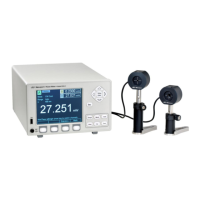120 Principles of Operation
Thermopile (818P Series High-Power) detectors, provide a small voltage
signal.
The 1936/2936 is capable of 76.3nV resolution in order to reach the
sensitivity limits of thermopile detectors.
Pyroelectric (818E Series Energy) detectors, deliver a peak voltage signal.
The1936/2936 is capable of capturing 2 µsec rise time voltage spikes so that
it may be operated with the fastest of these detectors.
9.5 Thermopile Detector Signals
Thermopile detectors respond with a voltage signal that slowly changes in
incident optical power. The time constant of most thermopile detectors is on
the order of 1 to 10 seconds.
Figure 65 Thermopile Signals exhibit 1 to 10 second time constants.
9.6 Pulse Energy Detector Signals
A Newport Energy detector will respond to a single radiant energy pulse with
a voltage pulse at its BNC output. This pulse exhibits a sharp voltage rise to a
peak followed by a slower voltage decay that “undershoots” zero volts before
settling back to zero volts. When a detector is operated within its proper
limits, the voltage difference from immediately before the sharp rise to the
peak is linearly proportional to the radiant energy.
If a second pulse arrives before the “undershoot” rises back to zero volts, the
voltage rise from this pulse will start from an initial negative value. At
sufficient energy pulse repetition rates, a negative “baseline” voltage will
develop from which the voltage rise must now be measured to achieve
accurate energy readings. The 1936/2936 Series contains baseline capture
circuitry that maintains its accuracy specifications over rep-rates ranging
from single pulse to 10 kHz.

